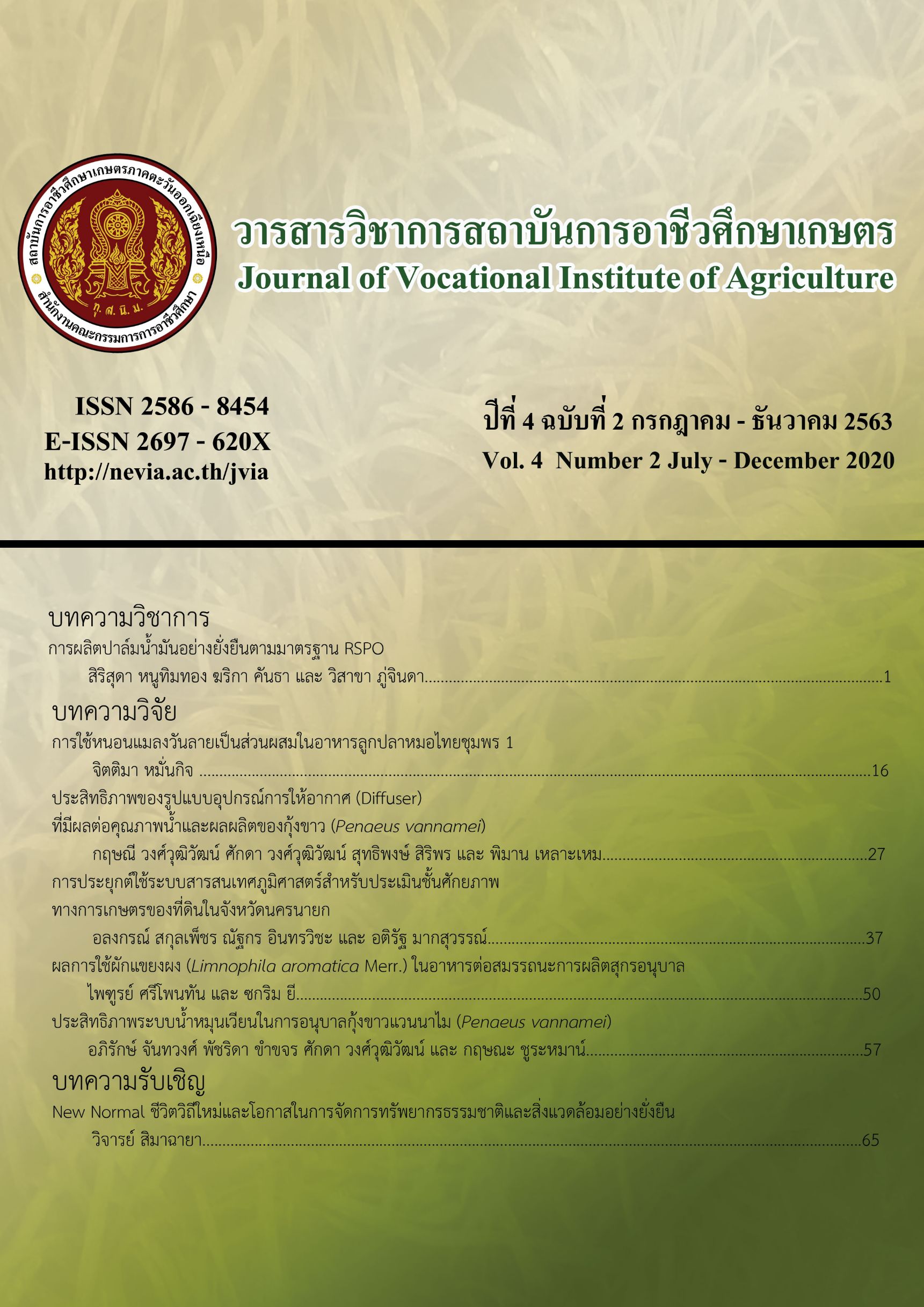Effect of Rice Paddy (Limnophila aromatica Merr.) powder In diet on the performance of nursery pigs production
Main Article Content
Abstract
The objective of this study was to investigate the effect of using vegetable spinach powder in diets on the performance of nursery pigs. Completely Randomized Design (CRD) was planned to use three pedigree piglets (Land x Large White x Duroc) aged 45 days, divided into 4 groups, 12 for each (5 male males 7 females) a total of 48 piglets. Each group of piglets will be fed as follows Group 1 Pig diets with antibiotics, Oxytetracycline 200 milligrams per 100 kilograms of food. Group 2 - 4 were fed pig diets mixed with Rice Paddy powder at the level of 100, 200 and 300 milligrams per 100 kilograms of swine food. Receive full food and water for 30 days.The results showed that group 4 pigs had the highest growth rate of 0.43 kilograms per animal per day, followed by groups 1, 2 and 3 with growth rates of 0.45, 0.45 and 0.42 kilograms per day, according to In order that there was no statistical difference (P> 0.05), the swine rate of swine group 4 showed the best swine rate of 1.55 followed by group 3 and group 1, the meat exchange rates were 1.58 and 1.75, respectively. There were statistically significant differences (P<0.05) and group 2 had a meat exchange rate of 2.03 parts. The amount of food eaten per animal found that group 2 pigs had the highest amount of feed per body 24.91 kilograms per animal, followed by group 1, group 4 and group 3 The amount of food consumed per unit was 23.88, 21.27 and 21.12 kilograms per animal. There is a statistically significant difference (P<0.01) and the cost of production per 1 kg of body weight found that group 4 pigs have the lowest production costs of 23.86 baht, followed by group 3. And group 1 had production costs of 24.02 and 27.05 per 1 kg of body weight increase respectively with statistically significant difference (P<0.05) and group 2 had a production cost of 30.50 baht per 1 kg body weight increase
Article Details
The content and information in articles published in the Journal of Vocational Education in Agriculture are the opinions and responsibility of the article's author. The journal editors do not need to agree or share any responsibility.
Articles, information, content, etc. that are published in the Journal of Vocational Education in Agriculture are copyrighted by the Journal of Vocational Education in Agriculture. If any person or organization wishes to publish all or any part of it or to do anything. Only prior written permission from the Journal of Vocational Education in Agriculture is required.
References
ยุทธนา ศิริวัธนนุกุล และคณะ. (2553). ผลของฟ้าทะลายโจรไทยหรือจีนและใบฝรั่งไทยหรือจีนต่อการรักษาโรคท้องร่วงจากเชื้อ อี.โคไล ในลูกสุกรระยะดูดนม. วารสารวิทยาศาสตร์และเทคโนโลยีมหาวิทยาลัยมหาสารคาม, 29(4), 389-403.
เสาวลักษณ์ พงษ์ไพจิตร และคณะ. (2553). การแยกเชื้อโรคระบบทางเดินหายใจและระบบทางเดินอาหารในสุกรจากฟาร์ม รายงานความก้าวหน้าครั้งที่ 2 โครงการวิจัยการใช้สมุนไพรในการลดต้นทุนการผลิตและเพิ่มประสิทธิภาพการผลิตเนื้อสุกรคุณภาพสูงและปลอดยาปฏิชีวนะตกค้าง. สงขลา: คณะทรัพยากรธรรมชาติ มหาวิทยาลัยสงขลานครินทร์.
ศศิธร คณะรัตน์. (2544). ปัญหาเชื้อดื้อยาในทางปศุสัตว์. การสัมมนาวิชาการโรคติดเชื้ออุบัติใหม่และอุบัติซ้ำ. กรุงเทพฯ: สำนักงานคณะกรรมการวิจัยแห่งชาติ.
ประพฤกษ์ ตั้งมั่นคง. (2555). ประสิทธิผลของสมุนไพรไทยต่อการยับยั้งการเจริญเติบโตของแบคทีเรีย Escherichia coli และ Salmonella Typhimurium. การประชุมทางวิชาการของมหาวิทยาลัย เกษตรศาสตร์ ครั้งที่ 50 (น. 203-210). กรุงเทพฯ: มหาวิทยาลัยเกษตรศาสตร์
Sandri, I. G., et.al. (2007). Antimicrobial activity of essential oils of Brazilian species of the genus Cunila against foodborne pathogens spoiling bacterial. Food Chemistry, 103(3), 823-828.
Katzer, G. (2004). Report problems and suggestion. Retrieved from https://www.uni-graz.at/de.
วรวุธ ชัยเนตร. (2548). การศึกษาผลของการใช้ผักแขยงและเปลือกแคเพื่อรักษาโรคท้องร่วงในลูกสุกร. วารสารมหาวิทยาลัยเทคโนโลยีราชมงคลอีสาน วิทยาเขตกาฬสินธุ์, 3, 150–154.
สาวิตรี รังกระโทก. (2555). ผลของสารสกัดหยาบจากผักแขยง (Limnophila aromatica Merr.) ในการ ต้านเชื้อแบคทีเรียก่อโรคอุจจาระร่วง. (วิทยานิพนธ์วิทยาศาสตรมหาบัณฑิต). อุบลราชธานี: มหาวิทยาลัยราชภัฏอุบลราชธานี.
นิติ อะทาโส และ สุวรรณี แก้ววิเศษ. (2555). ฤทธิ์ทางชีวภาพของสารสกัดใบผักแขยงและใบย่านางต่อ การยับยั้งแบคทีเรียก่อโรคในอาหาร (รายงานการวิจัย). กรุงเทพฯ: สถาบันวิจัยและพัฒนา มหาวิทยาลัยราชภัฏจันทรเกษม.
ไพฑูรย์ ศรีโพนทัน. (2557). การศึกษาผลของการใช้สมุนไพรใบฝรั่งในอาหารทดแทนยาปฏิชีวนะต่อ สมรรถนะการเจริญเติบโตของสุกรขุน (น้ำหนัก 60 - 100 กิโลกรัม) (รายงานการวิจัย). มหาสารคาม: วิทยาลัยเกษตรและเทคโนโลยมหาสารคาม.
รัตนา อินทรานุปกรณ์. (2547). การตรวจสอบและการสกัดแยกสารสำคัญจากสมุนไพร. กรุงเทพฯ: สำนักพิมพ์แห่งจุฬาลงกรณ์มหาวิทยาลัย.
สาธร พรตระกูลพิพัฒน์ และคณะ. (2547). ผลของสารสกัดด้วยน้ำและแอลกอฮอล์ของผลกล้วยน้ำว้าดิบ ใบข่อยและเปลือกข่อยต่อเชื้อ Escherichia coli (F 18+). การประชุมสัมมนาวิชาการเกษตรแห่ง ชาติประจำปี 2547 (น. 357-361). ขอนแก่น: มหาวิทยาลัยขอนแก่น.

